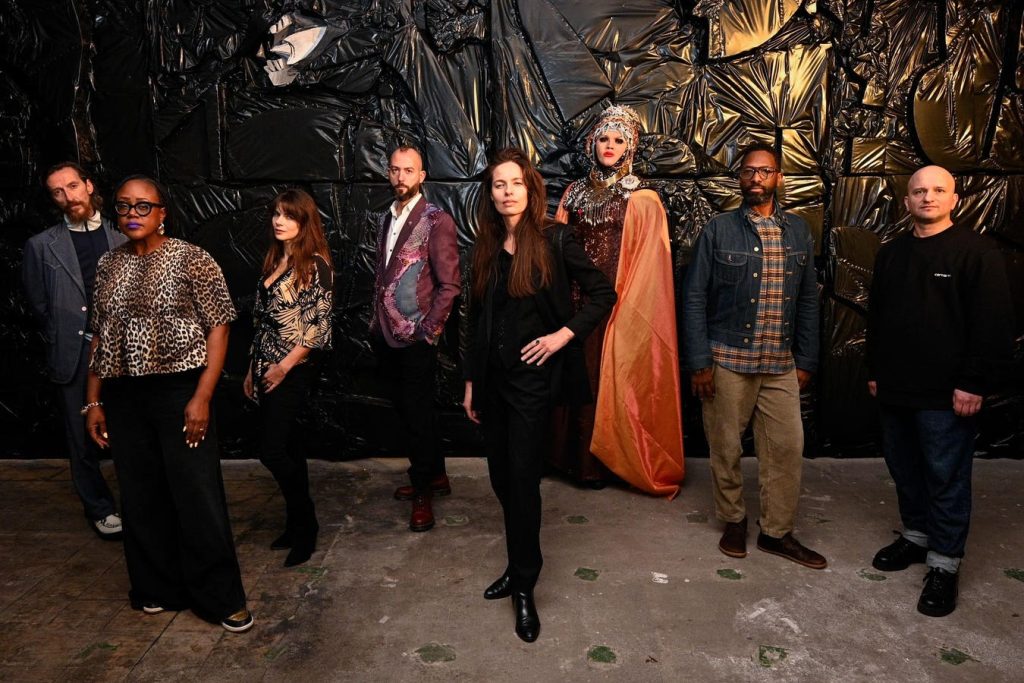‘Fragile’ artists pictured from left to right: Craig Robertson, Sharon Walters, Martha Freud, Ian Brennan, Leila Bartell, Curator Daniel Lismore, Curtis Holder and Kostya Benkovich. The artists are pictured with Oksana Mas ‘Ukrainian Guernica’.
© Ben Montgomery Photography
A collective of artists couldn’t capture the zeitgeist in a more timely and prophetic way than in ‘Fragile’, an exhibition curated by artist Daniel Lismore at the Bomb Factory in London. As the new world order appears to crumble before our eyes and conflict rumbles around the world, the use of art as a channel for activism and comment on the world around us couldn’t be more important.
Lismore’s thoughtful curation celebrates the resilience and vulnerability of artists overcoming oppressive regimes or environments and he has bought together 20 international artists who are commenting on the fragility of the contemporary world as it teeters on the edge of more conflict and reaches a tipping point for climate change. Exiled artists Oksana Mas, Kostya Benkovich and Nadya Tolokonnikova (Pussy Riot) have created powerful artworks and installations reacting to the trauma of war.
Daniel Lismore in front of Oksana Mas ‘Ukrainian Guernica’. Photographed by Lee Sharrock
© Lee Sharrock
I walked through the exhibition with Lismore and he explained the inspiration behind the concept and title: “To be frail is the most human of characteristics. It is in fully accepting this condition that we can recognize the greatness of our plight the courage it takes to face absolute evil, to endure and to be resilient in even the most extreme situations. In my experience, art has been the answer transforming pain into purpose and serving as a bridge to something greater. Every artist in this exhibition brings forth a piece of that transformative power. Their work is a testament to resilience and courage, each piece carrying a message that breaks through silence and reshapes understanding.”
A percentage of every sale from the exhibition will go to the charity Artists at Risk, the official partner of the exhibition. Fragile is presented by Bird&Carrot Productions and the Tsukanov Family Foundation in support of artists who have been persecuted, politically exiled or subjected to racial or gender injustice. The exhibition shines a light on the resilience and vulnerability of artists navigating perilous environments.
Pandemonia with Torn & Frayed Image Credit Ben Montgomery Photography
© Ben Montgomery Photography
Some of the featured artists are commenting on the fragility of the body or mind or exhibiting works that reflect experiences of racial or gender prejudice, such as Trans artist Trinity Tristan who lost use of their hands and now uses their body to create beautifully fragile body prints on fine silk, or Pandemonia whose new self-portrait “Torn & Frayed” depicts a “disintegrating Pandemonia Venus”. Pandemonia explains: “What does Fragile mean to me? The wheels are in motion—we are in fragile times. War, climate change, and AI are disrupting our world. When Daniel Lismore asked if I would like to be involved, I felt compelled to create something for the show.”
Pandemonia and Charlotte Colbert artwork in ‘Fragile’ exhibition. Photograph by Lee Sharrock
© Lee Sharrock
Charlotte Colbert is exhibiting a sculpture that celebrates bodily resilience and encourages pride in our scars or flaws. She explains. “Fragility is a perspective. It’s sometimes a strength. We can reclaim what hurt us and make it our superpower. The piece I have in the show has scars. When we are kids, we are proud of our scars but as we grow up we are taught to be ashamed of them. Why? Scars are victory marks. Triumphs against adversity and death.”
Curator Daniel Lismore with Charlotte Colbert and her sculpture ‘Mastectomy Mameria’. Image Credit Daniel Rachev Photography.
Copyright Daniel Rachev Photography
Nicola Turner, who recently exhibited “Meddling Fiend”, a vast horsehair sculpture in the courtyard of the Royal Academy of Arts for the 2024 Summer exhibition, has created a new sculpture called “En Pointe” for Fragile using a pitchfork, sickle, vintage sheep shears and horsehair to reflect on hidden layers of history. The resulting sculpture is both fragile and also menacing, reminiscent of an alien-like figure from H.G. Wells’ ‘Brave New World’.
Nicola Turner sculpture. photograph courtesy of Lee Sharrock
Copyright Lee Sharrock
A focal point of the exhibition is a museum-worthy, powerful reimagining of Picasso’s anti-war masterpiece ‘Guernica’ by Ukrainian artist Oksana Mas titled “Ukrainian Guernica”. Picasso painted ‘Guernica’ in 1937 in response to the devastating bombing of the Basque town of Guernica during the Spanish Civil War. Mas has recreated the image of carnage on the same scale as Picasso’s original, with the addition of black body bags referencing those used for casualties of the war in Ukraine. She first saw a print of Guernica during her childhood, and in later life her experiencing of seeing the original masterpiece was overwhelming. When Russia attacked Ukraine in 2022 and cities and villages were bombed, creating mass casualties, she channelled her trauma into a recreation of ‘Guernica’.
Daniel Lismore photographed in front of Oksana Mas ‘Ukrainian Guernica’. Photograph by Lee Sharrock
Copyright Lee Sharrock
Oksana Mas says:“In my desperation and turmoil, I decided to recreate Guernica at its original dimensions. But instead of a flat painting, I made it volumetric—to give the observer a sense of the dead bodies and the layers. It is awkward, sharp, and shapeless. Sometimes, only fragments emerge—hands, heads, hooves. The light from the buzzing old lamp in my work burns even stronger, and I left the mouths open, screaming the screams I had heard in the museum when looking at Guernica.
I finished my work by wrapping my Guernica in the same revolting black film used in Ukraine for the mass graves. Friends brought it to me from Kyiv. I couldn’t escape the thought: ‘This same film could lie between the layers of the dead.’ Once I wrapped my Guernica in this film, all I could feel was numbness—like the emptiness at a funeral when you’re completely lost for words. This is my only work about the war in Ukraine. I couldn’t create anything else—neither before nor after.”
Another focal point of the exhibition created by an exiled artist is Kostya Benkovich’s “My Suitcase” installation, which was inspired by the words of a lady who had hastily escaped from Ukraine with her family at the outset of war, who he overheard saying: “My suitcase is all I have remaining of my former life”. Benkovich was exiled for his opposition to the Russia’s war on Ukraine and references the displacement of refugees as well as acting as a metaphor for oppression and imprisonment.
Kostya Benkovich with ‘The Suitcase’ Installation’ Image Credit Ben Montgomery Photography
© Ben Montgomery Photography
Kostya Benkovich: “By combining steel reinforcement bars –symbolising confinement and oppression–with the image of a suitcase—a universal emblem of forced displacement—I aim to highlight the plight of those who have been uprooted by war. A suitcase often becomes the sole connection refugees have to their homeland, a small, constrained space for essential belongings and memories.”
Daniel Lismore is a believer in the power of art as a sanctuary and conduit for unheard voices, and he says: “Art has been both my sanctuary and my voice. Art, in its truest form challenges and provokes. Often meeting resistance or fear from those unsettled by the unfamiliar. It is this tyranny of the majority that threatens anyone who is different any artist, any minority.”
Behind a black curtain is an installation by Joe Corré, son of Dame Vivienne Westwood and Malcolm McLaren. Titled “Burn Punk (Ash from Chaos)”, the epic artwork features a glass coffin bearing McLaren’s death mask and containing the ashes of £6 million worth of punk memorabilia, which was publicly burnt in 2016 to condemn the commodification of counterculture and climate inaction. “Burn Punk (Ash from Chaos)” is displayed in Fragile alongside original audio and video footage of Corré’s protest action.
Joe Corre with ‘Burn Punk (Ash from Chaos)’
Copyright Ben Montgomery Photography
Joe Corré comments:”The works I have contributed reflect the fragility of our world and our planet. With the climate crisis escalating, everything seems tied to capitalism and a financial system that perpetuates environmental harm—investing in fossil fuels and systems that threaten our survival.
My piece is about emphasizing that we don’t need to dwell on the importance of punk anymore. That was my point when I showcased the work originally, during the UK establishment’s celebration of the 40th anniversary of the Sex Pistols’ Anarchy in the UK.”
With the support of Joe Corré and all the artists who have contributed work to this powerful, thought-provoking exhibition, Daniel Lismore is in a way continuing the legacy of Dame Vivienne Westwood, a true pioneer of art as a form of activism, whose warnings about climate change and oppression of freedom of speech were eerily prophetic. Lismore was great friends with Westwood and has been a vocal activist for LGBTQI+ rights and other important causes for many years. Hopefully through exhibitions like Fragile we can open a dialogue about fractures within our society and our world and move towards healing those divisions.
Curator Daniel Lismore with Marc Quinn ‘Gazing at the Burning World’. Image Credit Ben Montgomery Photography
© Ben Montgomery Photography
Daniel Lismore: “Together, these works create a powerful conversation, inviting us all into a deeper shared experience in a call for empathy, resilience and a commitment to compassion.”
Fragile is at the Bomb Factory until 2nd December, 2024.
Installation image of ‘Fragile’ at Bomb Factory. Photograph Courtesy of Lee Sharrock
Copyright Lee Sharrock
Source: https://www.forbes.com/






More Stories
NFL Picks, Props And Odds For Week 13 Prime Time Games 49ers-Bills And Browns-Broncos
The World’s Best Whiskey—According To The Authors Of Bourbon Lore
Of Toys And Tokens – In Conversation With India’s Top NFT Artist